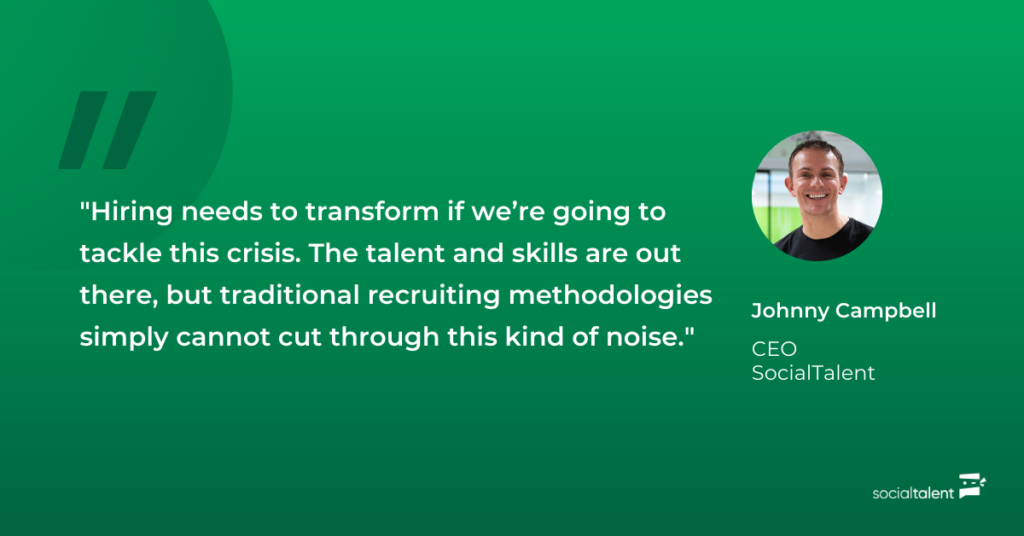Skills vs. Experience: Which Matters More in Today's Job Market?
Hiring is tough right now.
And I don’t mean to throw salt in the wound, but it seems as if almost every talent report published is just confirming the fact:
- 4 in 5 employers can’t find the skilled talent they need. (ManPower)
- By 2030 there’ll be a talent deficit of 85.2 million workers. (Korn Ferry)
- Yet unemployment is drastically lower than it’s been in years. (Eurostat)
There’s an unsteady feeling amongst TA professionals, like we’re grasping around in the dark for a simple solution, hoping that things will just magically correct themselves. But I fear that’s not what’s in-store.
Hiring needs to transform if we’re going to tackle this crisis. The talent and skills are out there, but traditional recruiting methodologies simply cannot cut through this kind of noise. It requires a mindset shift and an openness to embrace change – to tweak how we hire to improve who we hire.
And if you haven’t guessed already, I’m of course talking about skills-first hiring!

The skills-first dilemma
I want to start off by saying this: skills-first hiring isn’t a silver bullet.
The klaxon calls towards this approach have been sounding for years as experts and practitioners extolled the benefits and necessities of putting skills at the forefront of hiring. But listen, if you’re part of that lucky 20% who aren’t having any issues finding talent – amazing – you should stop reading now and continue on with your day!
While skills-first hiring is set to become an imperative process, I won’t lie, it requires more effort, more rigor, and more time.
Why should we adopt a skills-first approach?
It almost feels like an oxymoron to say it, but the current, mainstream hiring process is not particularly well-designed to find talent.
The way we source, assess, and shortlist candidates is so hugely focused on elements that act as a proxy to the skills needed for a role. Think about it – we scan a CV or quiz an applicant and make inferences about ability from other sources. We essentially assume that this person will have the specific skills we’re on the lookout for because they worked at X company, went to X university, and held this particular role.
And this often works! There are definite threads of success with this approach. However, it also discounts huge pools of potential talent. Why? Because the actual skills that the role may require could be found in countless other people, but having these proxy conditions like years of experience or particular job titles, act as an unnecessary barrier to entry.
Skills-first hiring subverts this process and tailors recruiting efforts to identify and assess the skills in a candidate that will lead to success.

Skills-first hiring in process
By removing certain criteria and shifting priorities away from perceived notions of pedigree, you open your search up to a bigger, more diverse audience of talent. And to put that in numbers, according to LinkedIn, adopting a skills-first approach can increase your talent pool tenfold.
But how can we do this? What steps must be taken to create a hiring process that centers on skills?
Job descriptions:
- Consider removing educational requirements: In the US, 70% of jobs require a bachelor’s degree, but only 37% of the workforce has one.
- Don’t list ‘years of experience’: Placing a floor or ceiling on years of experience is both arbitrary in terms of ability, and potentially discriminatory based on age.
- Is sectoral experience really required?: Too often low performers with only basic skills are hired just because they have a lot of ‘industry experience.’
Sourcing:
- Avoid job title searches: Searching the entire profile/CV typically increases results 3x.
- Search for related skills: Get inspired with related skills by using this LinkedIn tool here.
- AI and synonyms: Leverage generative AI to write boolean search strings containing various synonyms for your targeted term.
Talent Advisory:
- Lead with data: Skills-first hiring isn’t for every role. If the data shows that the talent pool is too small/competitive/expensive, prove this first!
- Use examples: Research the existing team on LinkedIn and demonstrate instances where people have been successful but perhaps didn’t have the ‘right’ job title or experience when they first joined.
- Focus on what bad looks like: It’s often easier for a hiring manager to describe the missing skills of a poor performer – these are your key skills!
Skill assessments:
- Assessments can replace degree requirements: Online assessments are often a more equitable way to test for specific hard skills.
- Soft skills can also be assessed: Emerging platforms like Pymetrics and Arctic Shores use AI to model the soft skills required to make candidates successful in different roles.
- Skills development: Many skills can be trained in weeks or months. Try to dissuade hiring managers from making these mandatory.
Interviewing:
- Behavioral interviewing: Lean on TMAAT (tell me about a time) questions for pre-identifed skills and rank answers against a pre-defined rubric.
- Probe into the how: Find the how in the candidate’s response.
- Pivot with situational questions: Redirect the interviewee by asking them how they might deal with a similar situation but under different constraints.
Learning and development:
- How long will it take to learn a skill?: Some skills can be learned in a few weeks, others take years. Only hire for skills that take a long time to develop.
- Mastery vs. Competence: It may only take a few months to become conversant in a new language, but mastery takes years. Assess whether competence or mastery is required.
- What L&D resources are available?: Research what courses/programs/tools your organization has so that you can quickly fill gaps that may otherwise preclude certain candidates.
Internal mobility:
- Reminder – don’t underestimate internal talent: Outside hires take 3 years to perform as well as internal hires in the same job.
- Are you up-to-date on internal talent?: Make sure you’re keeping track of internal talent’s skill base.
- Workforce planning: Identify skill gaps upfront and begin building the internal skills you need tomorrow, now.
It feels like hiring is going through a crucial moment of transition right now. But given the difficulty in finding key skills and talent, the conditions are ripe for this important shift. It’s even been noted that job postings on LinkedIn requiring four-year degrees have decreased by 5% in the last year. Change is happening!
By making a few adjustments to how we hire, focusing more on skills and less on more arbitrary proxies like experience, you build a muscle that will result, not only in a larger scope of talent to recruit within, but better quality and more diverse candidates too. It’s a win-win-win!
